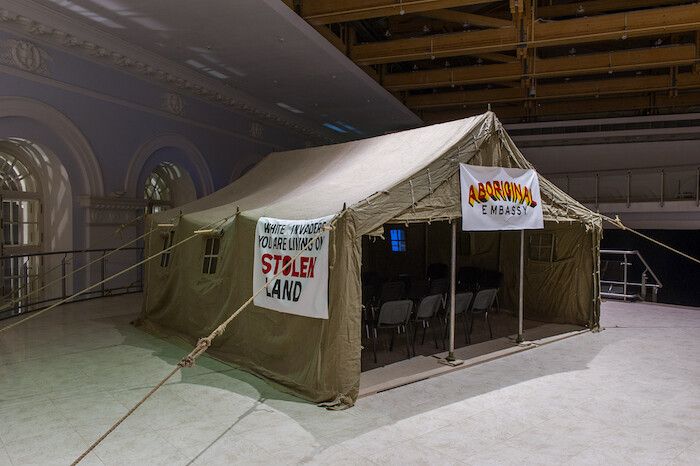Categories
Subjects
Authors
Artists
Venues
Locations
Calendar
Filter
Done
May 15, 2024 – Review
24th Biennale of Sydney, “Ten Thousand Suns”
Harry Burke

If “Ten Thousand Suns” has a patron saint, it’s Malcolm Cole, an Aboriginal and South Sea Islander dancer who died from HIV/AIDS in 1995. On view at Chau Chak Wing Museum—one of six venues across the city—Sydney-based photographer William Yang’s documentary portraits of Cole and the Aboriginal Islander Dance Theatre in the 1970s gleam with the young man’s grace. Next to them, paintings by Martin Wong, who died from the same illness in San Francisco in 1999, venerate working and incarcerated peoples in the artist’s trademark gravelly facture. The biennial probes the interconnectedness of different liberation movements—as spotlighted in the affinities shared by two Chinese diasporic portraitists, for instance, or personified within lives such as Cole’s.
In 1988, during the nationwide bicentennial of the First Fleet’s landing on the Eora land that they named Sydney, Cole helped to design the first Aboriginal float at the city’s Gay and Lesbian Mardi Gras, in which he paraded in drag as British naval officer Captain Cook. Yuwi, Torres Strait, and South Sea Islander artist Dylan Mooney’s mural Malcolm Cole – larger than life (2024) at White Bay Power Station memorializes the jubilant dancer, his face painted with ochre, in a sassy, wide-brimmed Royal …
April 28, 2020 – Review
22nd Biennale of Sydney, “Nirin”
Andrew Brooks and Astrid Lorange

Nirin—a word found in the language of the Wiradjuri people, an Aboriginal nation in New South Wales—can be translated as “edge.” The 22nd Biennale of Sydney’s artistic director, Wiradjuri artist Brook Andrew, explains how this concept animates the exhibition: “Nirin is a world of endless interconnected centers; a space to gather and to share, rejoice, disrupt, and re-imagine.” Led for the first time by First Nations artists, this biennale was to be an articulation of Indigenous internationalism, a refusal of the logics of white supremacy, and an assertion of the creativity, generativity, and resistance of First Nations people.
The physical exhibition was to encompass the ancestral lands of the Gadigal people of the Eora Nation, the Boorooberongal people of the Dharug Nation, the Dharawal people, the Bidjigal people, and the Gamaygal people. Its sites—including Cockatoo Island, a convict prison that became a shipyard in the middle of Sydney Harbor, and the Art Gallery of New South Wales, which contains a large collection of colonial artworks—were to be central to a curatorial aim to explore the entanglement of dispossession and resistance that emerges from a colonial world-making project, while the artists involved—Arthur Jafa, Tony Albert, Unbound Collective, Latai Taumoepeau, Sammy Baloji, …
April 4, 2016 – Review
20th Biennale of Sydney, “The future is already here—it’s just not evenly distributed”
Jon Bywater

One of the most affecting commissions of the 20th Biennale of Sydney is placed out on its own—“in between” its six main venues—at one end of the city’s Botanical Gardens. Archie Moore’s A Home Away From Home (Bennelong/Vera’s Hut) (2016) in part re-imagines the diminutive shelter offered to an Indigenous Australian collaborator in the white settlement of Sydney. It is a believable historical forgery, blending in with, and at the same time dwarfed by, the stately architecture of Government House. A quiet soundtrack of Aboriginal singing accompanied by clapsticks emanating from the otherwise apparently entirely European structure renders poignant its form, scale, and site.
If a white Australian expresses the opinion that immigrants should be sent back to where they came from, the appropriate retort is: “So, when are you leaving?” The unprecedented displacement of people today is Stephanie Rosenthal’s starting point for the biennale. Her post-Documenta 11 curatorial process has operated with an informant network of “attachés,” and her thematic elaboration presents the work through seven “Embassies.” Reclaiming the term, the embassies are imagined as “borderless” “safe places,” “transient homes for constellations of thought.” Yet, in a place where Indigenous Australians were not recognized as citizens until as recently as …